Gobo and Miso Takikomi Gohan is a Japanese mixed rice dish with burdock root and carrots. In this version, I add miso to the soy sauce-based seasonings to bump up the umami factor. Enjoy this delicious mixed rice in place of white rice at any meal.
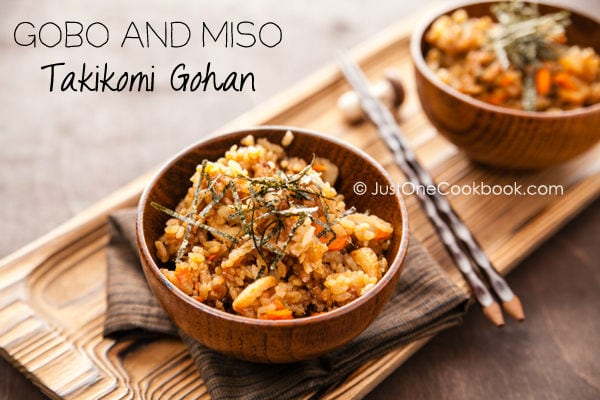
Takikomi Gohan is a Japanese rice dish typically seasoned with soy sauce. Although I’ve seen Takikomi Gohan on a menu at a high-end Japanese restaurant here in the San Francisco Bay Area, most of you probably haven’t heard of this dish.
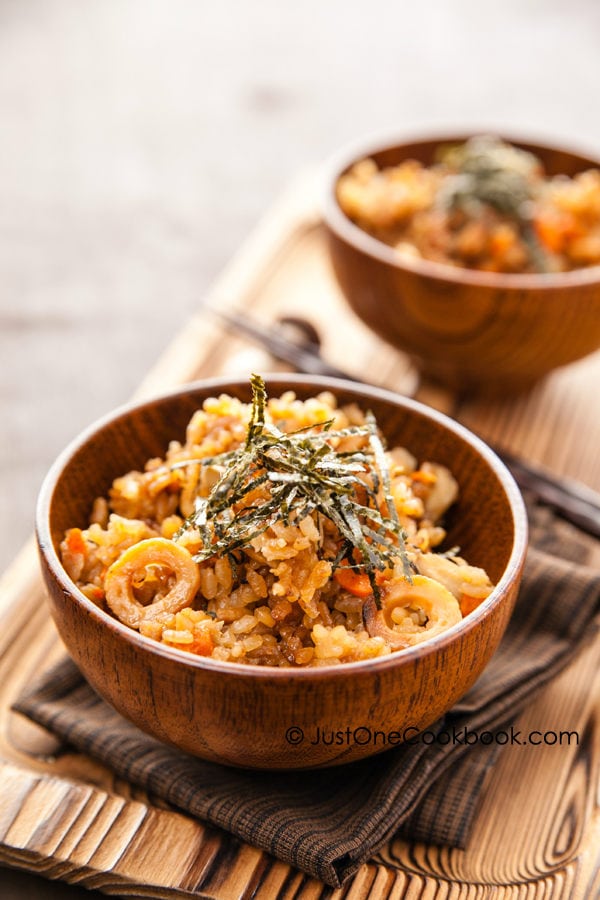
In Japan, depending on the season, we add different kinds of vegetables, meat, and mushrooms so you enjoy the food each season offers and get extra nutrition instead of just plain white rice. People are always creative in regard to the ingredients they put in.
Today I added leftover fish cake called Chikuwa and Gobo root. I also added miso this time because both ingredients go really well with the miso flavor. If you are tired of just plain rice, I hope you will add this recipe to your repertoire.
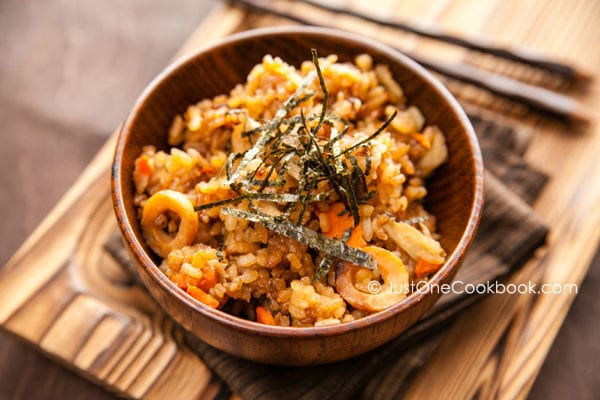
Wish to learn more about Japanese cooking? Sign up for our free newsletter to receive cooking tips & recipe updates! And stay in touch with me on Facebook, Pinterest, YouTube, and Instagram.
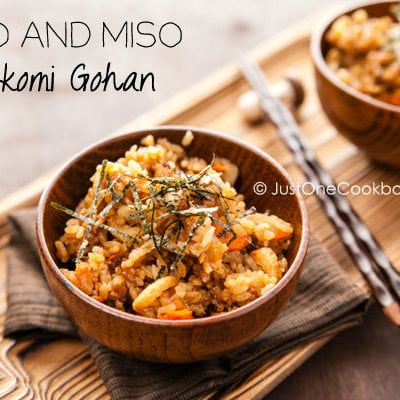
Gobo and Miso Takikomi Gohan
Ingredients
- 2¼ cups uncooked Japanese short-grain white rice (3 rice cooker cups; yields 6⅔ cups (990 g) of cooked rice)
- 1 gobo (burdock root)
- 1 carrot
- 2 pieces chikuwa (fish cake)
For the Seasonings
For Serving
- yuzu kosho (Japanese citrus chili paste) (optional)
- shredded nori seaweed (kizami nori) (to garnish)
Instructions
- Gather all the ingredients. Rinse 2¼ cups uncooked Japanese short-grain white rice until the water is almost clear. If you‘re not sure how to rinse the rice properly, see the rinsing section of my tutorial How to Make Rice. Drain well in a fine-mesh strainer, shaking off the water out. Transfer to the inner bowl of the rice cooker. Tip: If you don‘t have a rice cooker, see how to cook short-grain rice with a pot over the stove, Instant Pot, or donabe.

- Peel 1 gobo (burdock root). Cut it in half lengthwise, then thinly slice it diagonally.

- In a medium bowl, soak the gobo in water for 15 minutes to prevent it from changing color. Change the water a few times and drain well.

- Peel 1 carrot. Cut it in half lengthwise and slice thinly.

- Cut 2 pieces chikuwa (fish cake) into thin pieces.

- In a small bowl, combine 4 Tbsp soy sauce, 3 Tbsp miso, 2 Tbsp mirin, and 1 Tbsp sake and mix well.

- Pour the seasonings into the rice cooker and mix well.

- Then add water up to the 3-cup line on the inner bowl.

- Add the gobo root, carrot, and chikuwa on top of the rice. Do not mix together with rice. Rice cooks evenly when it‘s not mixed with other ingredients.

- Place in the rice cooker and start cooking. If you have a Mixed Rice option, use it (see Notes below).

- When the rice is done cooking, wait 10 minutes before you open the rice cooker to allow it to finish steaming. Mix well and serve the Takikomi Gohan with yuzu kosho (Japanese citrus chili paste) for spicy taste and garnish with shredded nori seaweed (kizami nori).

To Store
- You can keep the leftovers in an airtight container and store in the freezer for a month. I prefer freezing the cooked rice to refrigerating it. You can read more about it in my tutorial How to Store Cooked Rice.
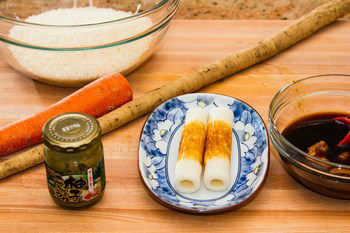

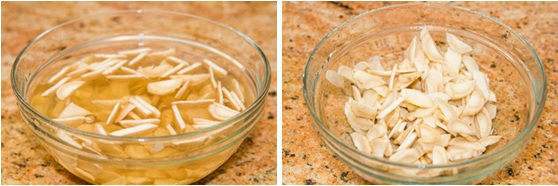
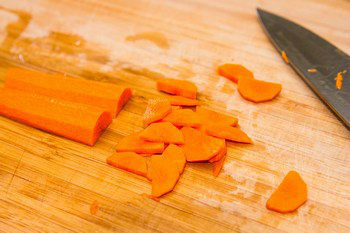
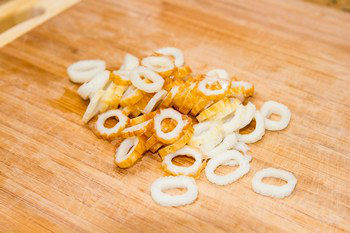
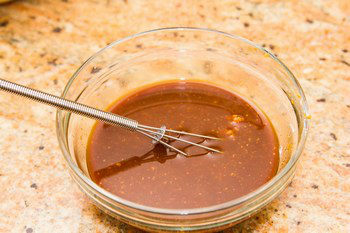

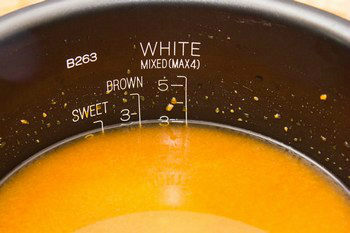
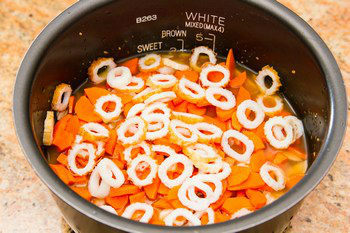
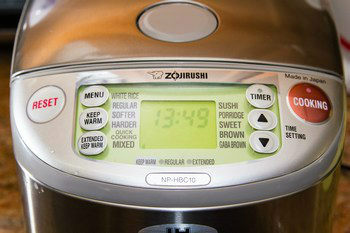
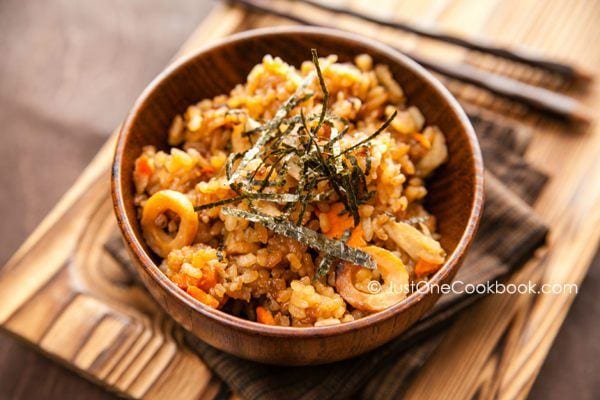










Hi Nami,
Thanks so much for this recipe! I just finished eating a bowl of it and it was absolutely delicious. I winged it with the ingredients, using what I had on hand: chicken thighs, cabbage, carrot and dried daikon and shiitake mushrooms. Such an easy and satisfying meal…especially in a Zojirushi. 🙂 Thanks again!
Hi Karen, Thank you very much for trying Nami’s recipe!
Nami and the JOC team are so happy to hear you enjoy the Takikomi Gohan.☺️
If I want to cook this on the stove without a rice cooker, is the water to rice ratio 1:1? If not, what is the rice to water ratio.? Thank you.
Hi Joyce,
We recommend using a 1:1.1 ratio, but 1.1 is the total amount of the liquid. So you have to subtract the number of liquid seasonings from this number to find the water amount.
For example, 3 rice cooker cups of rice (3 x 180 ml = 540 ml) needs 540 ml x 1.1 = 600 ml liquid (7 Tbsp of liquid seasoning x 15 ml + 495 ml water), and make sure to soak the rice in this liquid for 15~20 minutes before you start to cook over the stove.
We hope this helps!
Thank you for the water to rice ratio information. I want to try the stovetop method of cooking this time, as last time I made your takikomi gohan in my “old fashion” rice cooker and much of the seasoning was located on the bottom of my rice pot below the perforated plate. I have all the ingredients, so I will be making this very soon. I have tried many of your recipes and have enjoyed them all.
Hi Joyce,
It is our pleasure!
Please make sure to mix the water, liquid seasoning, and rice well when you soak the rice. And mix one more time before you place the vegetables on top of the rice.
Thank you for trying many of Nami’s recipes!🙂
[…] Gobo Miso Takikomi Gohan […]
[…] Sansai: The vegetable mix is the most difficult one to find for this recipe. But it is the main ingredient, and by substituting it, it basically becomes a different dish. If you’re curious to try, I recommend trying my other mixed rice recipes like Takikomi Gohan, Ginger Rice, Sweet Onion Rice, and Gobo & Miso Takikomi Gohan. […]
[…] Gobo and Miso Takikomi Gohan […]
[…] Takikomi Gohan […]
Hi Nami,
Will be the same if I just use regular jasmine rice, since I don’t have japanese short grain rice. Please post more takikomi gohan 🙂 its just make making lunch for the kids the nest day easier.
Hi Julie! Jasmine rice to me has certain fragrance and once it’s cooked, it has pretty obvious smell to it. It goes well with other cuisine, but to me, it doesn’t go with Japanese food so I don’t use it for Takikomi Gohan. Jasmine rice also separated and they don’t stick each other… and I think takikomi gohan works great with stickier Japanese rice (don’t get confused with “sticky rice” – that’s glutinous rice, not the same as steamed rice). 🙂
Hi, I don’t have this rice cooker. Can I use regular setting on a regular rice cooker?
Hi Clara! I apologize for my late response. Yes, that’s okay. 🙂
Hey Nami, I can’t wait to try this recipe but I don’t think I can get my hands on any gobo root. I was wondering what other things you put in?
Thanks!
Hi Rachelle! There are many things you can add – almost anything. For meat, I like adding chopped chicken thigh pieces (cut smaller so you don’t have to eat big chunk). I like adding all kinds of mushrooms such as shiitake, shimeji, etc. For veggies, satsumaimo (japanese yam), green onions, onion, corn, green peas, anything that goes with miso flavor. Fish cakes and aburaage (deep fried tofu pouch) add nice flavor too. I’m not sure how easily these ingredients are accessible, but you can add your favorite ingredients that work with this flavor. No specific rule, but keep it simple with 2-3 (at most) ingredients. Make sure the ingredients compliment to each other. Depending on the ingredient, adjust the miso amount as you don’t want to overwhelm the plain flavored ingredients. Hope this helps. 🙂
Hi Nami, love your recipes and beautiful blog. I started my first Japanese cooking when I bumped into your blog few months back and now terriyaki salmon, pork rolls, Saba, miso soup are our family favourite dishes. Keep it up ! Can you let me know how to cook this takikomi gohan with chestnut ?
Hi Ann! Thank you for your comment! I’m so happy you started to cook Japanese food! 🙂 I’ve been waiting to buy nice chestnuts (I only see very small kinds, and they are not so good…). Every year I look for good quality ones but hard to find. :/ If I find them, I’ll make chestnut rice and hope to share it. It’s kind of hard to write a recipe in a comment. Wish me luck to get good chestnuts this year! 🙂
Hi Nami, I made this over the weekend and it was definitely a nice change to plain rice! I really liked the balance of salty, sweet and even slightly bitter from the burdock. And, I can’t possible complain about the extra nutrition :). Thanks!
Hi Janice!
Thank you so much for trying this recipe. I’ve been planning to update the horrible picture but I haven’t had the chance to replace it.
I appreciate your time to write me your feedback, and thank you so much!!!